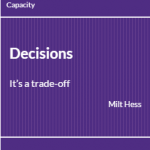Background on Tough Decisions
 In any organization progress can be stymied by unresolved issues. It’s counterproductive to keep rehashing the same question from week to week, perhaps making a decision today only to have it reconsidered and undone tomorrow. An organization needs both a reliable method for making good decisions and the willpower to stand by them once made.
In any organization progress can be stymied by unresolved issues. It’s counterproductive to keep rehashing the same question from week to week, perhaps making a decision today only to have it reconsidered and undone tomorrow. An organization needs both a reliable method for making good decisions and the willpower to stand by them once made.
Milt Hess’s paper, Decisions – It’s a Tradeoff, offers a repeatable method for making good decisions even in the presence of ambiguity. (Sorry, but no help here with the willpower thing.) It includes techniques for identifying the best options and the relevant evaluation criteria, and for objectively characterizing the options in terms of the criteria. Since a decision almost always represents a tradeoff among competing objectives, the emphasis is on presenting the decision-maker with the basis for making a decision that reflects his or her priorities.
Key elements of the approach
- When evaluating the options, avoid vague terms like Excellent/Good/Fair/Poor. They’re subject to variable interpretations. Instead, treat each criterion as a continuum from best to worst, and select four points along the continuum that can be described unambiguously.
- Explore the ‘design space’ to develop a set of the best possible solutions to the problem. Although brainstorming would seem to be a good approach, it’s unreliable. Exploring the design space is a systematic approach that offers two benefits – clarity and completeness. Clarity because it enables you to explain how you developed the options. Completeness because it enables you to demonstrate that you’ve considered all the possibilities.
- Develop evaluation criteria that differentiate the options. Ensure that they are independent and at the appropriate level of abstraction.
- When presenting the analysis, don’t do arithmetic on the results; don’t assign weights and don’t add scores to find the ‘winner.’ Don’t automatically recommend the option with the most high ratings, since even one poor score may reflect a fatal flaw. Instead, present the results of the analysis as a tradeoff so the decision-maker can base the decision on the criteria he or she values most.
Follow this link to see Milt’s complete Decisions: It’s a trade-off paper which is available to IntelliVen students, clients, subscribers, followers, and visitors.
See also
By Milt Hess: Reducing Risk on Projects
Tools and Templates for growing organizations
Curated articles for growing organizations
About the author
During his 25-year career with American Management Systems, Inc., a management consulting and systems development firm, Dr. Milt Hess grew from early roles as a technical specialist on projects to become a senior consultant to international clients.
Among his accomplishments, he served as Technical Director for the AMS’s Defense Systems Group for ten years, and for six years he supervised the implementation of ISO 9001 in AMS’s European operations. Milt developed a number of innovative approaches to systems analysis, software development, and project management during this time. His Best Practices papers were widely distributed and used within the company, and he has rewritten several of them so they can now be made available publicly.
Milt earned his Bachelor of Engineering Science degree at The Johns Hopkins University and his Masters and Doctorate in the same field at Columbia University. His early work at Bell Laboratories involved analysis of mechanical failure in electronic devices. A career switch to computer technology led to roles at Bell Labs in computer center management and software development and testing.
He joined AMS after ten years at Bell Labs and retired in 2002 as a Vice-President. Now living in Santa Barbara, California, he is a volunteer computer coach at the public library, member of his neighborhood association board, member of the Library Board, and venue manager for the Santa Barbara International Film Festival.
